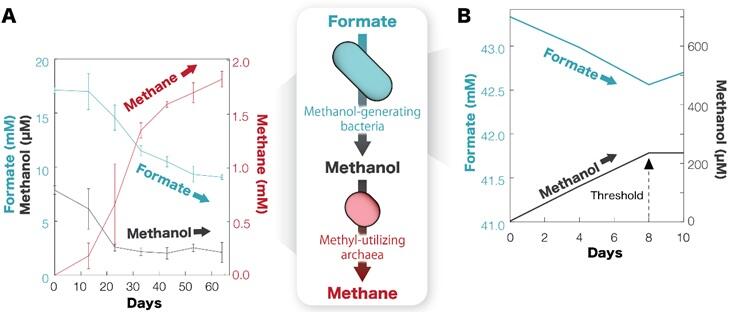Most natural gas (methane) is produced by subsurface microorganisms. Bacteria that break down organic substances into acetic acid and hydrogen and archaea that produce methane from these products have been identified. A research group led by Senior Researcher Masaru Nobu of the Super-cutting-edge Grand and Advanced Research Program, Institute for Extra-Cutting-Edge Science and Technology Avant-Garde Research at the Japan Agency for Marine-Earth Science and Technology (JAMSTEC), Chief Senior Researcher Souichiro Kato and Senior Researcher Kensuke Igarashi of the Bioproduction Research Institute, and Senior Researcher Daisuke Mayumi of the Research Institute for Geo-Resources and Environment at the National Institute of Advanced Industrial Science and Technology (AIST), has discovered a new methanogenic pathway comprising a bacterium that degrades formic acid, which is found widely in the subsurface, into methanol, and an archaeon that produces methane from methanol. This marks the discovery of the first bacterium in the world that produces methanol from formic acid. The study was published in Nature.

(B) Methanol production in monocultures of methanol-producing bacteria. Production ceased when approximately 200 µM accumulated.
Provided by JAMSTEC
Kato said, "Methylotrophic archaea that produce methane from methanol are universally found in the subsurface, but no one knew where methanol as feed came from."
The research group focused on formic acid, which is universally found in anaerobic environments such as underground. Nobu said, "A bacterium (Zhaonella formicivorans) isolated from an underground oil field possesses a gene for using formic acid but cannot grow using formic acid as a sole substrate, so we considered that it might produce methanol."
The research group found that the conversion of formic acid → methanol → methane occurred when the bacterium was co-cultured with a methylotrophic archaeon. Because methanol is toxic to organisms at high concentrations, its level was kept low to maintain a balance.
Furthermore, the research group showed that the methanol-producing bacterium had two pathways of methanol production: reduction of formic acid to methanol via formaldehyde and production of carbon dioxide via formic acid → glycine → serine.
The genome of the bacterium discovered in this study is expected to find various applications, such as the development of techniques to recover low-quality coal and crude oil remaining in depleted oil fields as methane through conversion.
Journal Information
Publication: Nature
Title: Methanol transfer supports metabolic syntrophy between bacteria and archaea
DOI: 10.1038/s41586-024-08491-w
This article has been translated by JST with permission from The Science News Ltd. (https://sci-news.co.jp/). Unauthorized reproduction of the article and photographs is prohibited.




